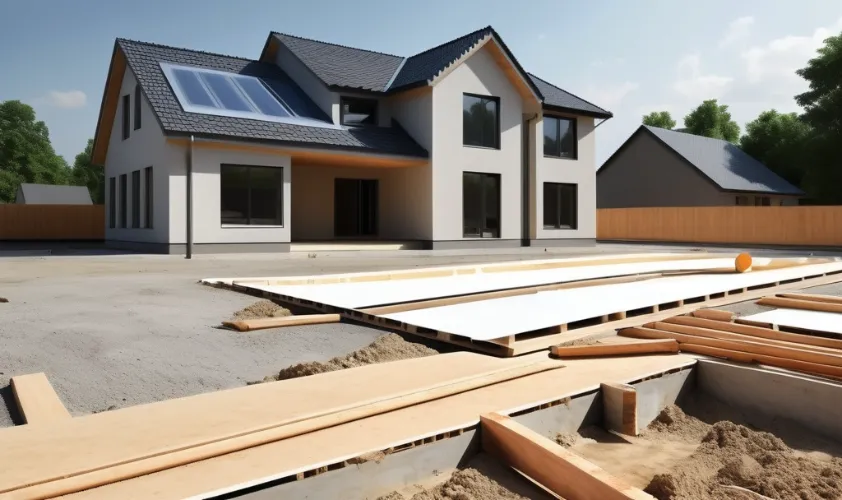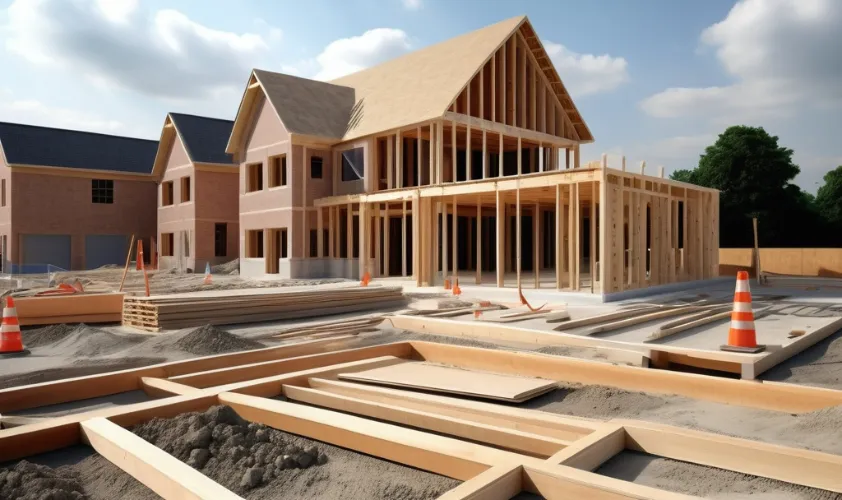The Art of Screeding: Why It Matters in Construction.
Construction is a complex and demanding industry that requires skill and precision. One aspect of construction that is often overlooked but is incredibly important is screeding. You may have heard the term before, but what exactly is screeding?
In simple terms, screeding involves spreading a layer of material over an uneven surface to create a level and flat finish. In the world of construction, screeding plays a vital role in ensuring that buildings are safe, sturdy, and long-lasting.
A properly screeded surface provides the foundation for all other construction work to be carried out on top of it. Proper screed is key to success in any project. It affects the outcome, whether you’re laying tiles or pouring a basement floor.
Without it, structures may be at risk of developing cracks or even collapsing over time due to uneven foundations. So, any serious builder or DIYer must know about screeding. They need to understand what it is, how it works, and why it matters.
What is Screeding?
When it comes to construction, screeding is the process of creating a smooth and level surface. This can be achieved by spreading a layer of material, such as concrete or mortar, over an existing surface or by using a pre-made screed board.
Screeding is vital in many construction projects. It ensures the final product is both strong and attractive.

The Purpose of Screeding
Screeding serves several important purposes in construction. For one, it helps to ensure that surfaces are level and even.
This is vital for projects like flooring or concrete slabs. An uneven surface could cause stability or drainage issues. Also, screeding can create a consistent finish on large areas. This makes it easier for other tradespeople to work on the surface.
Types of Screeds Used in Construction
There are many different types of screeds used in construction, depending on the specific needs of the project. The most common type of screed is a straightedge board made of wood or metal.
These boards can be used for both wet and dry screeding methods and are particularly useful when working with large areas. Another popular type of screed is known as a roller screed.
These devices use a roller system to distribute and level out materials like concrete or asphalt quickly. They are often used in commercial settings where time constraints are tight.
There are also laser-guided screeds. They use lasers to ensure a level finish on large surfaces, like warehouses and airport runways.
No matter which type you choose, use the proper technique. Pay attention to detail. This will yield good results with any tool for your project!
Why Do We Screed?
Screeding is an important part of the construction process that helps to ensure a level surface and proper drainage. Without a screed, it would be difficult to achieve a smooth and even finish on floors, walls, or other surfaces.
Also, screeding can help to prevent problems such as cracking or uneven settling over time.
One of the primary benefits of screeding is achieving a level surface. An unlevel floor can cause issues with furniture placement and safe walking. It may create tripping hazards.
Screeding allows for the creation of a perfectly level surface that meets the needs of the project at hand. Also, screeding ensures proper drainage. It allows water to flow away from the surface and prevents pooling that can cause damage over time.
There are many situations where screeding is necessary in construction. For example, when installing new tile or hardwood on concrete subfloors, screeding is often needed to create an even base.
Also, when pouring new concrete slabs for patios or driveways, screeding helps. It ensures a smooth, level finish that lasts for years.
It won’t crack or settle unevenly. Any situation where an even and level surface is required will likely need some form of screed work to achieve the desired result.

How to Screed
Screeding is vital in construction. It levels and smooths a surface before flooring or fixtures are added. Here is a step-by-step guide on how to properly screed a surface. First, prepare the surface by cleaning it thoroughly.
Make sure no debris, dirt, or dust remains on the surface. This will help ensure that the screed mixture sticks well to the surface.
Next, mark out any high and low points on the surface using a spirit level so that you can take appropriate action while applying the screed. Now you’re ready to mix your screed.
Follow the instructions provided by your supplier or use a pre-mixed solution if available. The mixture should be smooth and easy to work with.
Slowly pour the mixture onto the surface in small sections. Starting from one end of the area, use either a straightedge board or a trowel to spread and smooth out each section before moving on to the next one.
When applying screed, do not apply too much pressure. It can cause uneven areas due to inconsistent depth. Always maintain even hand pressure throughout the application process for the best results.
Tips and Tricks for Achieving a Smooth Finish
To get a smooth finish after applying screed, you can do a few things to make it easier. First, use long, sweeping motions when moving your straight-edged board or trowel across the area.
Short movements may leave bumps or ridges. Secondly, periodically check for high or low spots with your spirit level as you work on another section of the floor. This will help ensure an even finish.
but importantly, make sure you do not overwork each section, as this could lead to cracks and an uneven surface once the screed dries. By following these tips, you can achieve a smooth finish that will be perfect for your project.
Common Mistakes When Screeding
The Importance of Proper Screeding Techniques
When it comes to screeding in construction, proper technique is crucial. Screeding mistakes can lead to uneven surfaces, poor drainage, and even structural damage. It’s important to be aware of common screeding mistakes and how they can affect the outcome of a project.
Using Too Much or Too Little Material
One common mistake when screeding is using too much or too little material. If you use too much material, you can create high spots that will be difficult to correct.
On the other hand, if you use too little material, the surface may end up uneven and require additional work to level out.
Using just the right amount of material is essential for achieving a smooth and level surface. It’s important to follow the manufacturer’s instructions for the screed.
Also, ensure that materials are evenly distributed on the surface being worked on.
Effects on Final Outcome
Screeding errors may not always be immediately clear, but they can have major long-term effects on a project. If not corrected early on in the process, these mistakes may need costly repairs down the line.
For example, improper screed thickness can cause cracks in a concrete slab or floor. This may happen due to excessive shrinkage during curing or temperature changes over time.
Such damage could lead to high repair costs and long downtimes, hurting business operations.
It’s vital to avoid common screeding mistakes. Use proper techniques and the right amount of materials. Attention to these details can save time and money. It will also ensure a smooth, level surface for your construction projects.

Advanced Techniques for Screeding
A Laser-Level for Ultimate Precision
While screeding manually can provide a solid foundation, the use of a laser level offers ultimate precision. A laser level is a device that projects a precise beam of light, which allows contractors to achieve an even more accurate level.
This technology lets professionals measure and fix any surface flaws. It ensures the surface is perfectly level. Laser levels are very useful for large surfaces or specific requirements.
For instance, they’re often used for flooring in commercial buildings and hospitals. There, every inch must be perfect. A laser level may cost a lot upfront.
But, it saves time and money by reducing the need for later corrections. The results are worth it.
Using Power Screed Machines
Another advanced technique for screeding is using power screed machines. These machines have a long, high-speed vibrating blade. They quickly create an even layer of concrete or other materials across large surfaces, faster than manual methods.
Power screed machines work best on larger projects like slabs and roads, or where there is limited access, such as narrow trenches or tight spaces.
They are more precise than manual methods. They can create consistent vibrations over long distances with little effort from workers. These machines are more efficient than traditional methods. They also work better.
They help prevent errors from human mistakes, like accidental bumps or uneven spreading.
They need specialized training to use it correctly. But, once mastered, power screed machines are very effective. They quickly and efficiently produce smooth, even surfaces.
By using advanced techniques with traditional methods, contractors can achieve smooth surfaces faster and more accurately than ever.
Conclusion: The Importance of Screeding in Construction
Screeding is an important step in any construction project, which involves creating a flat and level surface. Screeding is key for any job, from a new concrete slab to tile floors. It ensures the result is both safe and nice to look at.
By using the right tools and techniques, you can achieve a smooth and even surface that meets all your construction needs. One of the main reasons why we screed in construction is to ensure proper drainage.
If water pools on an uneven surface, it can cause damage over time or lead to safety hazards such as slip-and-fall accidents. Also, screeding helps ensure floors are level enough to support heavy equipment or furniture without tipping over.
Without proper screed, you may end up with floors that slope or have dips, which can be frustrating to walk on. Screeding may seem simple. However, many factors affect the finish quality.
Every detail matters in creating an even surface. This includes using the right amount of material and ensuring proper curing times before adding layers or finishes. Taking your time and following the steps above will yield professional results on any construction project!

